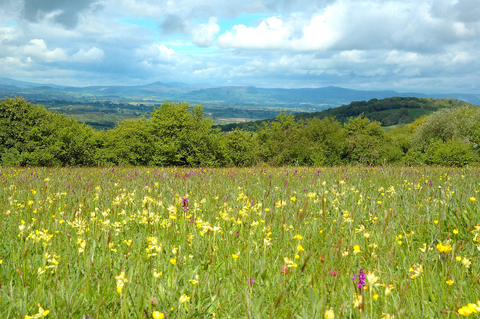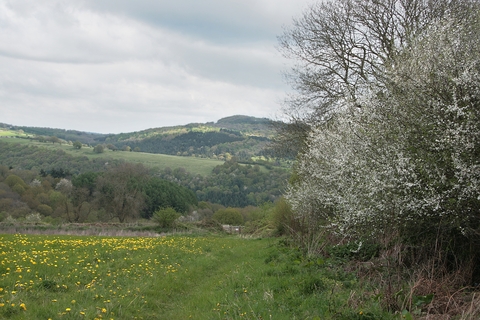Ten years ago, the former Prince of Wales launched Coronation Meadows to honour the 60th year of the late Queen’s accession to the throne. Gwent Wildlife Trust’s New Grove and Wyeswood Common nature reserves were selected as part of the initiative.
In the face of the catastrophic loss of 97% of our wildflower meadows since the 1930s, the plan was to create new and restored meadows using donor seed from remaining fragments of ancient and traditional meadows.
The Wildlife Trusts and Plantlife – charities for whom the former Prince of Wales was patron – worked together to identify 60 species-rich meadows which are known as Coronation Meadows, one for every year of the Queen’s reign at that time. These special places, including New Grove, became donors, providing precious seed to increase the amount of valuable and beautiful wildflower habitat elsewhere.
The charities have done an audit of the success of the project, which reveals that a fantastic 101 new wildflower meadows have been created or restored since the Coronation Meadows project began a decade ago, including Gwent Wildlife Trust's Wyeswood Common.
The charities are delighted that the Coronation Meadows project has increased the number of wildflower meadows and benefitted a vast array of wildlife, from bees and butterflies to bats and birds. The area is still expanding as the charities continue to harvest and spread the wildflower seed in localities close to the original sites so that the distinctive character of each area’s flora is preserved.
Biffa Award, through the Landfill Communities Fund, contributed £1million to fund the equipment and training needed for meadow restorations. In the first three years of the project alone, more than 700 volunteers gave their time to get the project off the ground. Seed was harvested from Coronation Meadows donor sites either as green hay, brush harvested seed or by hand, and this was used to seed second sites in the same area.
Talking about the success of Gwent Wildlife Trust’s Coronation Meadows, Head of Nature Recovery Gemma Bodé, said: “As well as providing a vitally important habitat for a range of flora, fauna and fungi our Coronation Meadows at New Grove and Wyeswood exist as exemplar nature reserves in Monmouthshire. Both sites demonstrate how with careful, long term management they can become havens for a host of important wildlife such as orchids, butterflies, bees and dormice.
“And in recognition of the importance of restoring meadows, which have sadly seen over 97% disappear since the 1930s, we’re working with hundreds of local land owners across Gwent to inspire them to re-establish and conserve these important habitats to benefit future generations of wildlife and people.”
Craig Bennett, chief executive of The Wildlife Trusts, said: “The expansion of our beautiful wildflower meadows is a wonderful legacy for communities everywhere to enjoy. The magnificent sight of wild orchids shimmering in a field of delicate wild grasses in the afternoon sun to the hum of bees is something that everyone deserves to experience and enjoy.
“As the nature and climate crises deepen, we must be bold if we want to reverse declines and help revive our meadow heritage. Ancient meadows have evolved alongside traditional farming methods over hundreds of years. Many of these have been selected as Local Wildlife Sites because of the rare and threatened plants that are found there but they have limited protection in planning policy. The next review of the National Planning Policy Framework later this year must see their protection strengthened. We also need to see greater support for wildflower meadows in the new farm environment schemes – it is critical that farmers are rewarded for restoring locally distinctive natural habitats where wild plants can thrive.”
Ian Dunn, CEO, Plantlife, said: “If you can, this Coronation year, make the opportunity to sit within an area of meadow or uncut grass. Look around at the colours and variety of plants. Then close your eyes and sense your surroundings through sound and smell. You’ll be amazed, reconnected with nature and feel just fantastic! We know healthy habitats such as meadows form the foundations of all successful conservation, as well as being at the roots of a healthy society and in addressing the climate challenges we face. At Plantlife we aspire to create a combined area equal to 20,000 new football fields of meadows before the end of this decade to give everyone the chance of experiencing the beauty and wildlife-rich meadows that were once commonplace. The exquisite Coronation meadows started 10 years ago give us confidence we can do so”.


